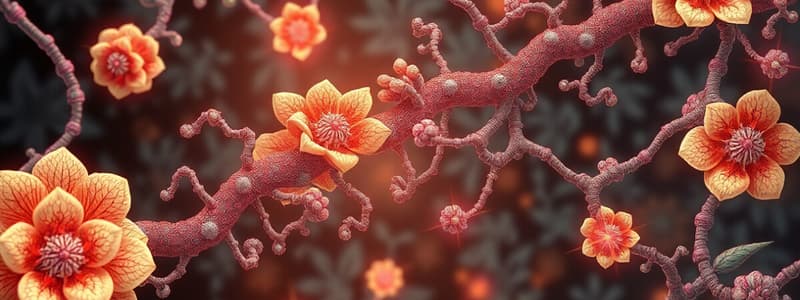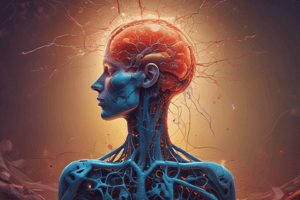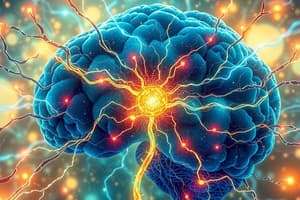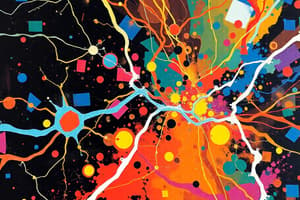Podcast
Questions and Answers
What is the general effect of an agonist on a neurotransmitter?
What is the general effect of an agonist on a neurotransmitter?
- It has no effect
- It reverses the effect
- It decreases the effect
- It increases the effect (correct)
What does a direct agonist do?
What does a direct agonist do?
- Inhibits the release of neurotransmitters
- Blocks the neurotransmitter synthesis
- Removes neurotransmitters from the synapse
- Binds with and activates a receptor (correct)
How does a direct antagonist work?
How does a direct antagonist work?
- By accelerating neurotransmitter reuptake
- By increasing neurotransmitter synthesis
- By stimulating neurotransmitter release
- By occupying space and blocking neurotransmitters (correct)
What disease is L-dopa commonly used to treat?
What disease is L-dopa commonly used to treat?
What neurotransmitter system does parachlorophenylalanine (PCPA) affect?
What neurotransmitter system does parachlorophenylalanine (PCPA) affect?
What is reserpine used for?
What is reserpine used for?
What is the primary effect of black widow spider venom on neurotransmitter release?
What is the primary effect of black widow spider venom on neurotransmitter release?
What is the effect of Clostridium botulinum toxin on acetylcholine release?
What is the effect of Clostridium botulinum toxin on acetylcholine release?
Which receptors does nicotine bind to?
Which receptors does nicotine bind to?
Where is muscarine found?
Where is muscarine found?
What type of receptors does muscarine act upon?
What type of receptors does muscarine act upon?
What is curare primarily known for?
What is curare primarily known for?
What receptors are blocked by atropine?
What receptors are blocked by atropine?
Cocaine acts as an agonist by blocking the reuptake of which neurotransmitter?
Cocaine acts as an agonist by blocking the reuptake of which neurotransmitter?
What is the origin of physostigmine?
What is the origin of physostigmine?
What enzyme does physostigmine prevent from breaking down acetylcholine?
What enzyme does physostigmine prevent from breaking down acetylcholine?
What is the primary effect of a synthesis agonist?
What is the primary effect of a synthesis agonist?
What class of drug is fenclonine?
What class of drug is fenclonine?
What is the primary effect of a storage antagonist?
What is the primary effect of a storage antagonist?
What is the primary effect of a release agonist?
What is the primary effect of a release agonist?
What type of receptor is stimulated by nicotine?
What type of receptor is stimulated by nicotine?
What is bradycardia?
What is bradycardia?
What is the effect of cocaine on dopamine levels in the synapse?
What is the effect of cocaine on dopamine levels in the synapse?
Which of the following is NOT a function of atropine?
Which of the following is NOT a function of atropine?
What molecule of cocaine blocks the reuptake of dopamine?
What molecule of cocaine blocks the reuptake of dopamine?
How physostigmine is used for Alzheimer's patients?
How physostigmine is used for Alzheimer's patients?
What receptors are found in mushroom (Amanita Muscaria)?
What receptors are found in mushroom (Amanita Muscaria)?
How does curare works in animals?
How does curare works in animals?
Which of the following diseases have little amount of dopamine activity?
Which of the following diseases have little amount of dopamine activity?
What can Clostridium Botulinum cause?
What can Clostridium Botulinum cause?
What type of therapy is used for a patient who does not respond to medication?
What type of therapy is used for a patient who does not respond to medication?
What does cocaine block?
What does cocaine block?
What does Clostridium botulinum toxins prevent the release of?
What does Clostridium botulinum toxins prevent the release of?
What blocks acetylcholine receptors (nicotinic receptors)?
What blocks acetylcholine receptors (nicotinic receptors)?
What receptors does Atropine blocks?
What receptors does Atropine blocks?
From where Physostigmine is obtained?
From where Physostigmine is obtained?
What effect does an antagonist have on a neurotransmitter?
What effect does an antagonist have on a neurotransmitter?
What is the function of a synthesis agonist?
What is the function of a synthesis agonist?
What neurotransmitter is affected by reserpine?
What neurotransmitter is affected by reserpine?
Nicotine binds to what type of receptors?
Nicotine binds to what type of receptors?
What is the effect of atropine on heart rate?
What is the effect of atropine on heart rate?
Flashcards
Agonist (Drug Action)
Agonist (Drug Action)
Increase the effect of a neurotransmitter.
Antagonist (Drug Action)
Antagonist (Drug Action)
Decrease the effect of a neurotransmitter.
Direct Agonist
Direct Agonist
A drug that binds to and activates a receptor, mimicking a neurotransmitter and altering synaptic transmission.
Direct Antagonist
Direct Antagonist
Signup and view all the flashcards
Synthesis Agonist
Synthesis Agonist
Signup and view all the flashcards
Synthesis Antagonist
Synthesis Antagonist
Signup and view all the flashcards
Storage Antagonist
Storage Antagonist
Signup and view all the flashcards
Release Agonist
Release Agonist
Signup and view all the flashcards
Release Antagonist
Release Antagonist
Signup and view all the flashcards
Nicotine as a Direct Agonist
Nicotine as a Direct Agonist
Signup and view all the flashcards
Muscarine as a Direct Agonist
Muscarine as a Direct Agonist
Signup and view all the flashcards
Curare as a Direct Antagonist
Curare as a Direct Antagonist
Signup and view all the flashcards
Atropine as a Direct Antagonist
Atropine as a Direct Antagonist
Signup and view all the flashcards
Cocaine as a Reuptake Agonist
Cocaine as a Reuptake Agonist
Signup and view all the flashcards
Physostigmine as an Inactivation Agonist
Physostigmine as an Inactivation Agonist
Signup and view all the flashcards
Study Notes
- Psychopharmacology studies how drugs affect synaptic transmission.
Drug Action on Synaptic Transmission
- Drugs can alter synaptic transmission by acting as agonists or antagonists.
- An agonist increases the effect of a neurotransmitter.
- An antagonist decreases the effect of a neurotransmitter.
- Direct agonists bind to and activate receptors, mimicking the neurotransmitter.
- Direct antagonists occupy the receptor site, preventing neurotransmitter binding.
Drug Actions and Examples
- Synthesis Agonist: Increases neurotransmitter production; L-dopa boosts dopamine levels, treating Parkinson's.
- Synthesis Antagonist: Reduces neurotransmitter production; parachlorophenylalanine (PCPA) inhibits serotonin synthesis.
- Storage Antagonist: Interferes with neurotransmitter storage; reserpine, used for high blood pressure, depletes neurotransmitters.
- Release Agonist:Promotes neurotransmitter release; Black widow spider venom triggers acetylcholine release.
- Release Antagonist: Inhibits neurotransmitter release; Clostridium botulinum toxin (Botox) prevents acetylcholine release, causing paralysis.
- Binding Direct Agonist:Mimics neurotransmitter at the receptor; nicotine binds to nicotinic acetylcholine receptors, opening ion gates, causing reward.
- Binding Direct Agonist: Mimics neurotransmitter at the receptor; muscarine, from certain mushrooms, binds to muscarinic receptors slowing heart rate.
- Binding Direct Antagonist: Blocks the receptor; curare blocks nicotinic acetylcholine receptors, causing paralysis.
- Binding Direct Antagonist: Blocks the receptor; atropine blocks muscarinic receptors, reducing saliva secretion, treating bradycardia.
- Reuptake Agonist: Inhibits neurotransmitter reuptake, increasing its synaptic presence; cocaine blocks dopamine reuptake.
- Inactivation Agonist: Inhibits neurotransmitter breakdown, prolonging its action; physostigmine inhibits acetylcholinesterase, improving memory in Alzheimer's patients.
Studying That Suits You
Use AI to generate personalized quizzes and flashcards to suit your learning preferences.




